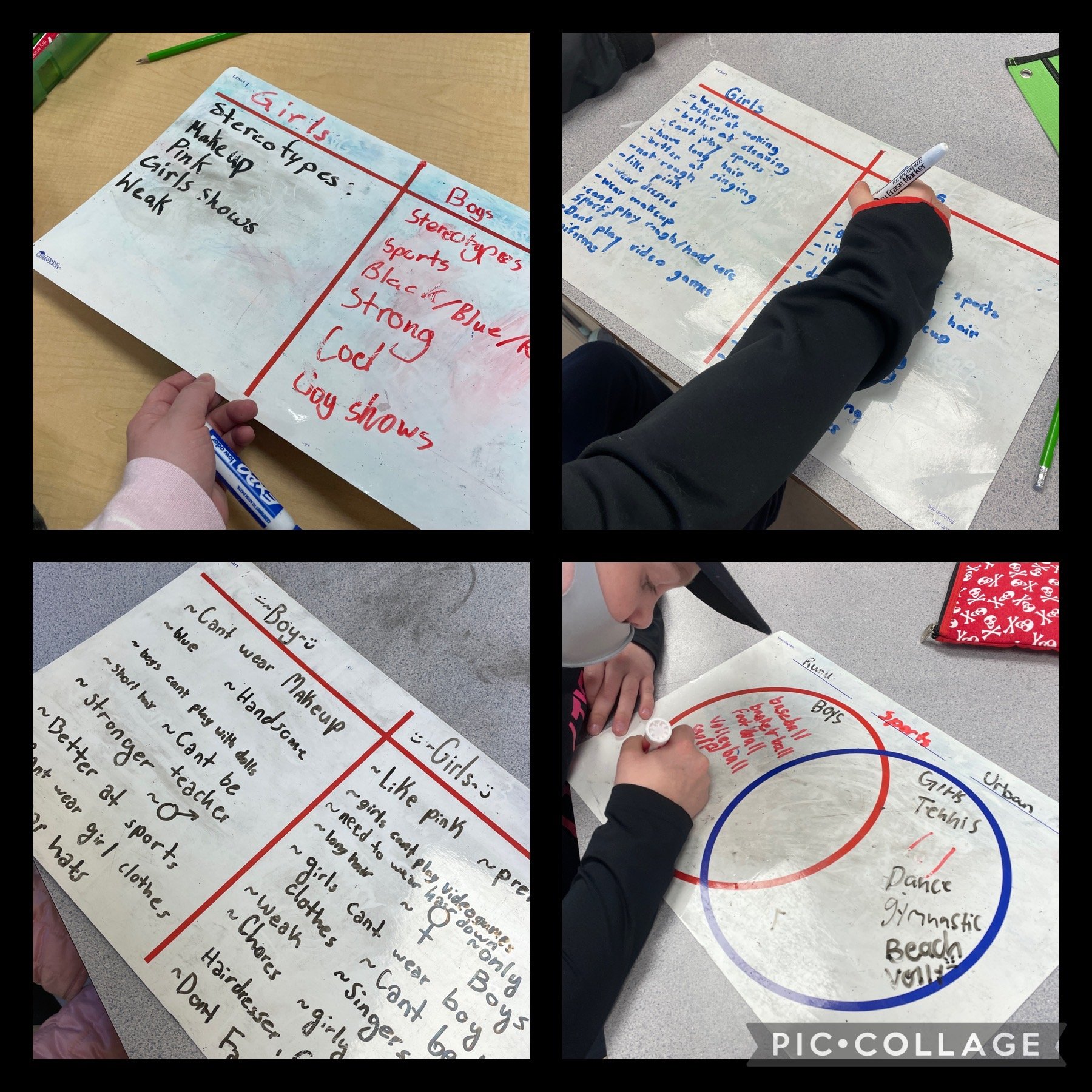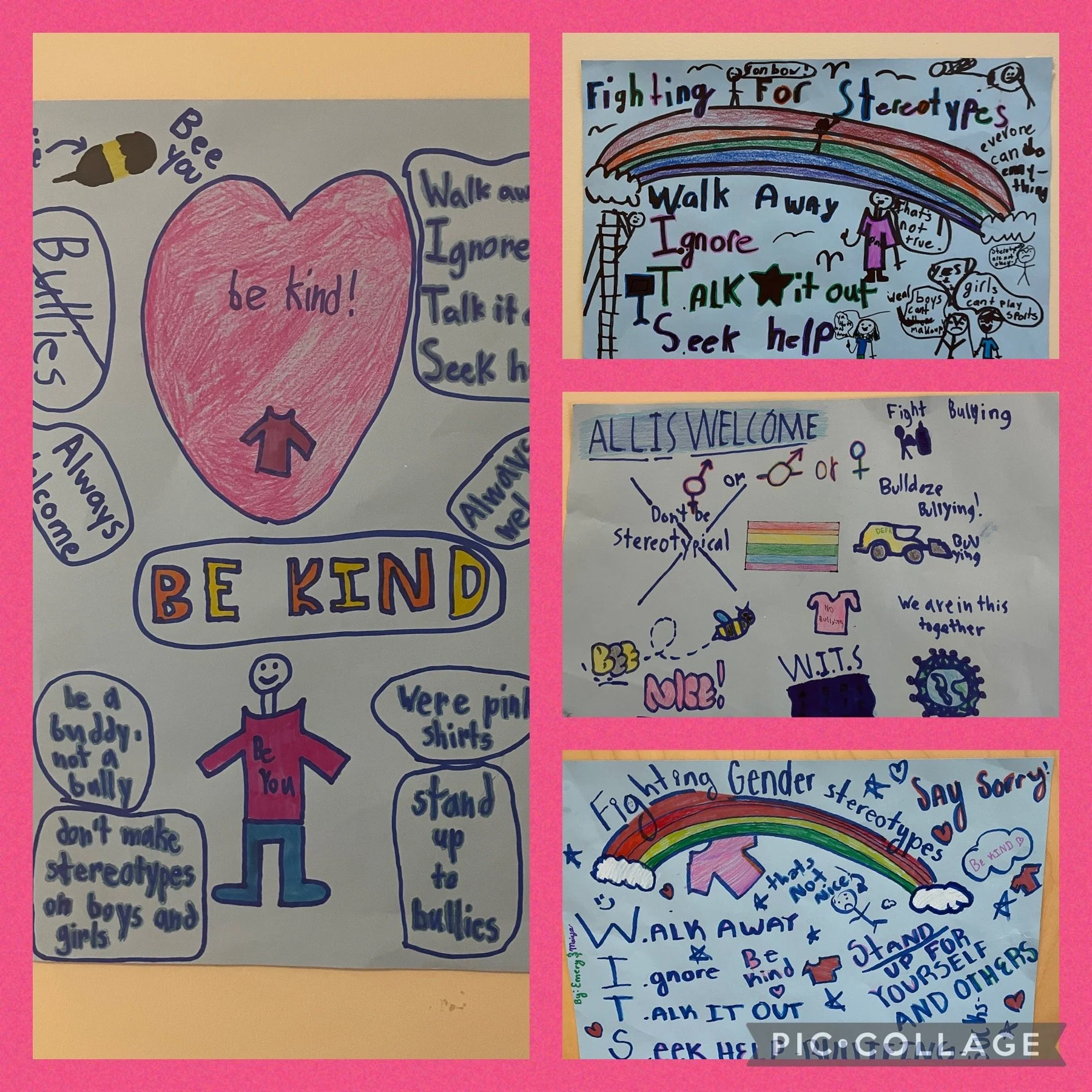Gender Stereotypes and Pink Shirt Day
Pink Shirt Day this year was Wednesday February 23rd. It is a day to talk about gender stereotypes, bullying, and kindness. What is explored and how it is explored differs from classroom to classroom and province to province. If you do not know about the history of Pink Shirt Day or the reasons behind it, please read the link attached and/or watch the video. This video was part of the lesson I did with my class.
This year, I decided to use Pink Shirt Day to start a discussion about gender stereotypes and norms. It was supposed to last about forty minutes…and became the entire morning. It was a powerful lesson in student voice and learning as we dug deeply into stereotypes. This blog post will outline the activities and what I learned from my kids.
Part 1: Brainstorm Gender Stereotypes (Original Lesson)
When the students arrived in the morning, each table group had a T-Chart whiteboard and whiteboard pens. The same chart was on the board with the headings: Stereotypes boys vs. girls. As the students came in, they started to talk about what stereotypes were and write ideas on their chart. I floated around and asked students from each table to put different ideas on the table on the whiteboard. This is often how I run group brainstorms. It allows groups that are stuck to start getting ideas and it allows the board to be populated with ideas without having to take one idea at a time.
This was supposed to be part one of the lesson and only take 15 minutes…. About 10 minutes in, we paused and looked at a definition of stereotypes. We had to unpack the difference between stereotypes based on gender and those based on sexual orientation. Sometimes the stereotypes overlap, but the distinction is really important to unpack. We talked about how gender is a spectrum and about the terms non-binary and trasngender. It was a powerful side discussion that I didn’t expect. This is not the first time we have explored these terms, but it was an important refresher.
About 10 minutes after unpacking the the definition of stereotypes, we stopped and used the ideas on the class brainstorm as a springboard for a discussion.
Part 2: 4 Corners Discussion and Class Discussion (Whoops…new)
Movement is so important for kids. I try to build movement into lessons and one way is with a Four Corners Discussion. I have four signs around my room ALL of the time that represent opinions:
Somewhat Agree
Somewhat Disagree
Strongly Agree
Strongly Disagree
I decided to use the class populated brainstorm to make statements and start discussions. A few of the statements I used included:
I like pink
I like long hair
I am good at sports
I am bad at math
Teachers often hold my work up in art to show what is good
With each statement, the kids moved to the answer they thought reflected them the best and we chatted. The deep roots of stereotypes were explored. I will highlight three of the statements.
Statement A: I wear cute clothing
Immediately all kids moved to somewhat or strongly disagree. I asked students to share what ‘cute’ clothings was:
We then unpacked why they thought these were cute. Lightbulbs went off. I shifted the statement to ‘It is easy to find comfortable clothing I like’. Most of the students in my class that identify is male moved to strongly agree, whereas the female identifying students moved across the spectrum. This led to comments like:
There was more, but these three comments stood out. Such thoughtful ideas from small humans.
Statement B: Teachers often ask me to demonstrate math problems
This is a heartbreak statement…again, the student in my class that identify as male moved more to the strongly and somewhat agree statements, and the students that identify as female were more evenly spread out:
We talked about how this stereotype is just a myth that is perpetuated and has dire consequences. Girls not going into ‘hard sciences’ when they get older because they never felt ‘good’ or supported in math. The flip question about art also had powerful results. The boys felt like their work was not shown as much because it wasn’t as ‘pretty’. Even with well meaning teachers, this bias accidentally comes through.
Statement C: I am good at sports
What was nice about this was how most of the kids actually identified in a positive way. Why I am including this statement is because of the discussion we had about the statement. Here is the brainstorm we created from our discussion in a much more legible form:
We talked about the Olympic hockey teams and how the women won gold…we talked about how unfair the stereotypes and rules were. We dug deep and it was hard. We talked about there fact that these stereotypes were wrong. Girls are strong and can play any sport they want. Boys can also be strong and participate in any sport they want. Sports DON’T have a gender.
Part 3: Add WAY More to Brainstorms (Whoops…new)
When we finished this powerful accidental conversation, the students asked if they could add more to their T-Charts, so I let them. The opposite side of the T-Chart was a Venn diagram and kids asked if they could use this side as well. The students thought of categories like sports, TV Shows, Books and thought about which ones were stereotypically marketed to different genders. It was an eye-opening experience.
Part 4: Beautiful Insight from a Student (Whoops…new)
As my students were adding ideas, one came up to me and said something very thoughtful. So thoughtful, I wrote in on the board:
The ‘it’ he was talking about was gender stereotyping and how ingrained it is in so many places within our society. I paused the class and asked a few yes/no questions. The students had to stand if the answer was yes and sit for no:
This problem seems big
I am surprised by how many examples of gender stereotyping we have found
The problem feels a bit hopeless
I think it can change
With each statement, we had students share why they were sitting or standing. We decided as a class that it is hard AND it can get better. We have to be the change. This led very nicely into the second part of the original lesson, reviewing the history of Pink Shirt Day and how it brings awareness to both bullying and gender stereotypes. It also shows how TWO kids can make a huge difference.
Part 5: Show Two Pink Shirt Day Videos (Original Lesson)
I showed two short videos about Pink Shirt Day and we discussed how TWO kids can make a difference.
Part 6: Think About Solutions & Make Posters (Whoops…new)
The students were challenged to brainstorms ways they can stand up to gender stereotyping at home and at school. How challenging ingrained thoughts, even in adults, is an important start. The kids asked if they could make posters…so we made posters and put them all up around the school. The kids were coming up with real solutions and they cared deeply about the topic because it impacted all of them.
So the posters were quick and there are some spelling issues. I don’t care. It was a beautiful initiative from the heart that came from a powerful discussion in our class.
Final Thoughts
This is an example of a lesson going astray and far deeper than I thought it would. This mattered to my kids and we spent half the day having powerful discussions. It means that next week, we will have a few double math days, and that is okay as well.
Students are like sponges. They want to learn and share. They have so much to teach each other. I challenge you to give your lessons space to go astray and watch amazing learning unfold.








